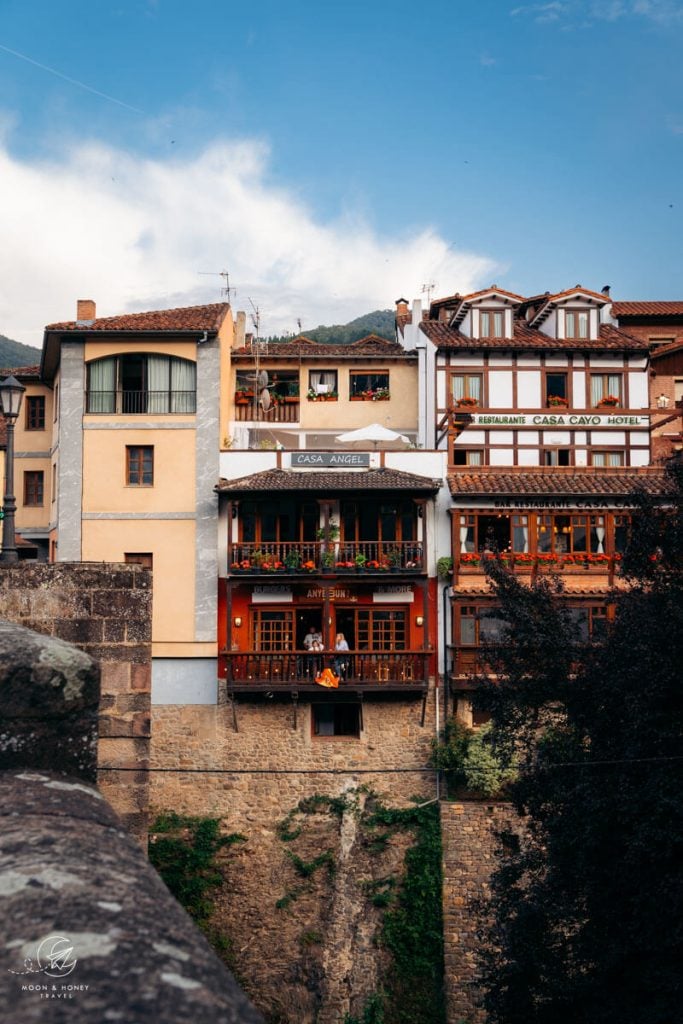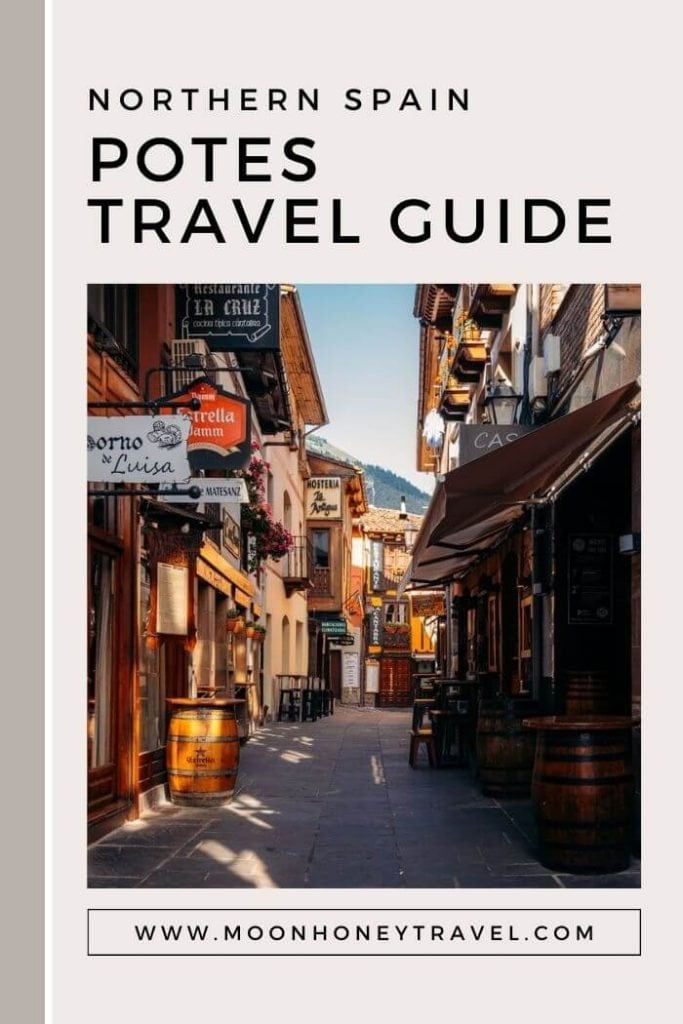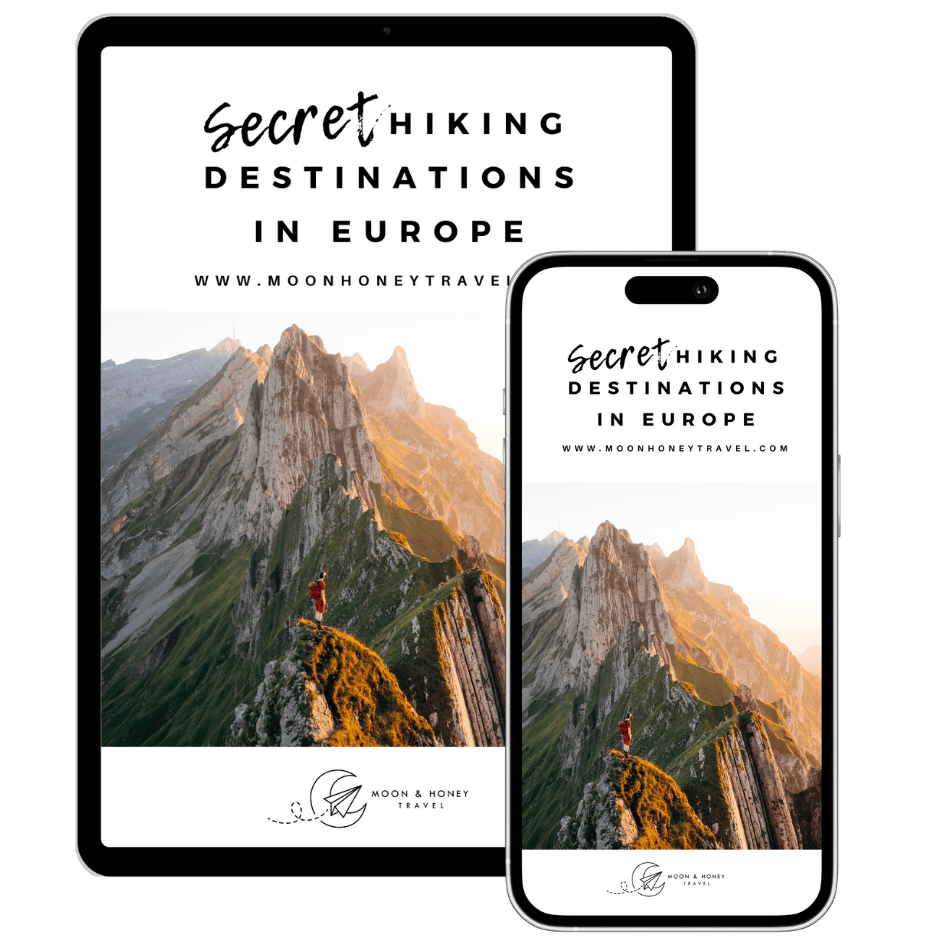Potes is a small medieval town in southwest Cantabria in Northern Spain. It’s located at the confluence of the Deva and Quiviesa rivers.
It’s the beating heart of rural Liébana, where cows and herdsmen roam the streets, Spanish mastiffs guard flocks of sheep, and pilgrims trek the El Camino Lebaniego.
Potes is also the gateway to Valle de Camaleño and Picos de Europa National Park. In fact, it’s one of the best places to stay for exploring the wildly beautiful Picos de Europa Mountains.
From Potes, you can drive through Camaleño Valley to various trailheads, including Fuente Dé.
Home to 1,350 residents, Potes is a place where everyone knows everyone. People wave, smile, and greet each other. When you visit, it feels like you’re walking into an extended family gathering (in the best possible way).
Our original plan was to spend 2 nights around Potes, but we loved it so much, we extended our stay to 4 nights. If our itinerary allowed for more flexibility, we would have stayed longer.
If you’re planning a road trip around Picos de Europa National Park, you will likely drive through Potes at some point. Stay here a few nights to experience the delights of the town and the surrounding scenery. You will not be disappointed.

- When to Visit Potes: May – October
- Events: Potes hosts a weekly market on Mondays.
- Best Restaurant: La Soldrería
- Where to Stay in Potes: Casa Cayo (budget), Apartamentos Casa de la Abuela (midrange), or Villa Elena (midrange with parking)
- Where to Stay in Camaleño Valley: Posada San Pelayo (budget), Apartamentos la Ventana de Mogrovejo (midrange), and Posada Laura (luxury)
Potes Map
1. Walk around the Town Center

It’s easy to fall in love with Potes. It’s an attractive riverside town with cobbled streets, stone bridges, and historic Casona montañesa buildings.
The town center is clustered around the Quiviesa and Deva rivers and the CA-185 road. It’s packed with patisseries, bars, taverns, restaurants, and shops.
Stone bridges tightly link the town center together, including the 13th century Bridge of San Cayetano.
Tucked away from the main thoroughfare, there’s a maze of quiet streets and alleyways lined with half-timbered stone buildings. There’s also a lovely pedestrian pathway that runs parallel to the river.

The main focal point of Potes is the 15th-century Infantada Tower, a medieval stone building that permanently houses the exhibition “Beatus of Liébana and his Beatos.” Beato de Liébana, famous for his Commentary on the Apocalypse, was a monk and theologian who lived in the nearby Santo Toribio de Liébana Monastery in the 8th century.
2. Dine in Potes

Much of the joy of visiting Potes is eating in Potes.
For coffee, orange juice, and delicious pastries, head to Pastelería Cafetería Wences 1929 (Google Maps).
For creative Cantabrian-fusion cuisine, eat lunch, or dinner at La Soldrería, located along Calle El Sol (Google Maps). The restaurant spills out into a private garden, tucked away from the busy areas of Potes. The service is impeccable. And, the food is EXCELLENT!!! We loved their seasonal salad, mushroom skewers, and boneless short rib. Here’s the menu. We regret not eating here more than once.

For artisan burgers, loaded friends, and river views, head to Anybun? (Google Maps). Their “Malibu Burrito” is also insanely good!!! If possible, grab a seat on the balcony, overlooking the river. The service is swift and friendly.
For Mexican cuisine, head to the heart-warming Las Mañanitas (Google Maps). The tacos were great, but the fajitas and the enchiladas lacked flavor. The owner and staff are all very welcoming and patient.

We also ate at Restaurante La Barrica de Potes, which occupies a romantic location overlooking the river (Google Maps). The food was very good, but not memorable.
Like everywhere else in rural Cantabria, dining hours are rigid. Lunch is usually available between 1 and 4 pm and dinner is usually available starting at 8 pm.
When we visited Potes in early June, securing a table wasn’t a problem. However, we were always early, arriving at 8 pm on the dot, because we were already starving. If you’re visiting later in the season, or on weekends, I would make dinner reservations.
3. Explore Valle de Camaleño

Camaleño Valley is essentially the upper Deva River valley, stretching between Fuente Dé, the source of the Deva River, and Potes.
Camaleño is also the western-most municipality of the Liébana district, sharing borders with both Asturias and León. It consists of 30 villages.
This verdant river valley is wedged between the Picos de Europa Mountains and the Cantabrian Mountains. The valley floor and slopes are cloaked in mixed woodlands of oak, beech, chestnut, ash, hazel, holly, and alder trees. At higher elevations (1600 – 2000 meters), the landscape is defined by sprawling mountain pastures, grazed in summer.
From Potes, you can drive the CA-185 road through the valley all the way up to Fuente Dé. The road passes by a number of small villages and hamlets. Other scenic mountain villages are located off the main road, high above the valley.
The main attractions in Camaleño Valley are the Fuente Dé Cable Car, Mogrovejo village, Canal de las Arredondas channel, Espinama Village, Via Ferrata de Camaleño, and the San Toribio de Liébana Monastery.
4. Watch a Cattle Drive

Starting on June 1st, farmers are allowed to move their livestock up to the mountain pastures (“Vega” in Spanish).
If you’re visiting Camaleño Valley in early June, you’ll likely see farmers and their families herding their bell-wearing animals up to higher-elevation meadows, passing through villages along the way.
These cattle drives take place in the late afternoon, or early evening.
During our stay, we saw five cattle drives, twice in our car and three times from our accommodation.
If you’re familiar with the German-speaking Alps, this is called an “Almauftrieb.”
5. Ride the Fuente Dé Cable Car

Fuente Dé is located at the end of the Camaleño Valley road in Picos de Europa National Park. Along with the popular Teleférico Fuente Dé cable car, there are two hotels here: Hotel Rebeco and Parador de Fuente Dé.
The most defining feature of Fuente Dé is the Vega del Naranco limestone cirque. Even if you don’t plan on riding the cable car, taking a walk around the meadows is reason enough to visit.
The Fuente Dé cable car links the valley to the central massif of Picos de Europa. In 4 minutes, it whisks 20 passengers up to an impressive limestone moonscape.
The Fuente Dé cable car mountain station is called El Cable (1834 m), which is also the starting point for the Puertos de Áliva hike (PR24) and the Horcaos Rojos summit hike (PR23)
We hiked the popular Puertos de Áliva trail from El Cable all the way back down to Fuente Dé. This 15.2 km hike takes 5 hours.
Read our Puertos de Áliva trail guide for a complete trail description.
6. Eat Lunch in Espinama

Espinama is a village that straddles the Nevandi River in Camaleño Valley. It’s located on the main road near Fuente Dé (5-minute drive).
It’s one of the livelier villages in Camaleño, boasting a modest collection of accommodations and restaurants.
After hiking around Fuente Dé, we recommend stopping in Espinama for lunch.
We ate a mouthwatering meal at Vicente Campo Restaurante (Google Maps), starting with the cheese platter featuring Picón Bejes-Tresviso (blue cheese), Quesucos de Liébana, and other local cheeses.
Given its proximity to Picos de Europa National Park, Espinama is a popular base for hikers. Check out these Espinama accommodations: Posada Maximo (budget), Albergue Turístico Briz (budget), Hostal Puente Deva (budget), and Apartamentos Remoña (midrange).
Look for accommodation in Espinama.
7. Hike From Brez to Canal de las Arredondas

Brez is a mountain village high above Camaleño Valley.
It’s not a tourist hot spot as there are no restaurants, bars, or tourist-catering establishments. But, it is the starting point for the very popular Brez to Canal de las Arredondas circuit trail.
This 2-hour circuit hike to the base of Canal de las Arredondas is easy and suitable for children. The trail dips in and out of forest and affords magnificent views of the Eastern Massif of Picos de Europa.
Read our Brez-Canal de las Arredondas trail guide for a full trail description.
8. Visit Mogrovejo Village

Mogrovejo is a scenic village with a medieval tower perched in the highlands above Camaleño Valley.
From the village, you can follow the “Bajo Los Picos” hiking trail to the foot of the Eastern Massif. This 9-km-circular route takes 3 hours to complete.
We visited Mogrovejo after hiking in Brez. We grabbed a drink at the only bar-café and walked around the village.
Consider staying in Apartamentos la Ventana de Mogrovejo for the spacious 2-bedroom apartments, mountain views, garden access, and unique location.
9. Santo Toribio de Liébana Monastery

The Santo Toribio de Liébana Monastery is located in the Cantabrian Mountains in Liébana, only 3 kilometers outside of Potes.
This significant Roman Catholic site, dating back to the 6th century, supposedly harbors the largest preserved piece of the True Cross, the cross upon which Jesus Christ was crucified.
It’s believed that Santo Toribio (Saint Turibius of Astorga) transported the relic to Astorga, Spain, from Jerusalem in the 5th century. In the 8th century, Christian refugees from Astorga, fleeing Muslim invasions, carried the holy relic with them to Liébana.
In the 16th century, monks split the relic in two pieces and mounted them in the shape of a cross in a gilded frame. This relic is located in a reliquary altar in the baroque-style Lignum Crucis Chapel inside the Monastery.
In 1958, scientists concluded that the wood of the True Cross relic is older than 2,000 years. They also identified that the wood is Cupressus Sempervirens L, a type of cypress tree that is native to Palestine.
We were curious about the monastery, because we saw pilgrims walking in the area. We learned that San Toribio de Liébana Monastery is located at the end of the Camino Lebaniego pilgrim’s path. Some pilgrims will venture off El Camino de Santiago del Norte (Camino del Norte) at San Vicente de la Barquera in order to walk the Camino Lebaniego to this monastery. From here, they will either end their journey, or continue to Santiago de Compostela.
If you visit the Santo Toribio de Liébana Monastery, don’t miss the Door of Forgiveness (Puerta del Perdón in Spanish), a wooden door set in an archway on the church’s main entrance.
By stepping across the threshold, pilgrims are granted indulgence (Jubilee Years only). A Jubilee Holy Year is every time St. Turibuis’s St. Turibius’s Feast Day falls on a Sunday.
An indulgence reduces purgatorial time, or punishment for sins committed in life. Though the Catholic Church outlawed the sale of indulgences in 1567, there are five places that have the privilege of issuing perpetual indulgences, including Rome, Jerusalem, Santiago de Compostela, Caravaca de la Cruz, and the San Toribio de Liébana Monastery.
Location | Monasterio de Santo Toribio de Liébana, 39570 Camaleño, Cantabria, Spain | Google Maps
Parking | There’s a large, free parking lot just below the monastery | Google Maps
10. Visit the Sotama Visitor Center in Tama

This Picos de Europa National Park visitor center is located in Tama, very close to Potes. It houses an extensive audiovisual exhibition about the park in Spanish and English. It’s very well done and educational.
If you need something to do on a rainy day, this is a good option.
If you drop by, pick up a park map. Though this tourist map is not a substitute for a real trail map, it helped us better understand the locations and numbers of the official park trails.
Location | Avenida Luis Cuevas, 2-A 39584, Tama, Cillorigo de Liébana, Cantabria | Google Maps
Where to Stay in Potes
Potes Hotels and Accommodations

Most accommodations in the town center of Potes do not offer on-site parking. If you’re traveling to Potes during the week, you shouldn’t have any problems finding parking. If you’re visiting Potes during the weekend (or during peak seasons), parking will be more difficult. If you’re concerned about parking, stay at Villa Elena.
Top Choice – Midrange | Villa Elena is an intimate B&B, located outside of the town center, but still within walking distance (7 minutes). Stay here for the quiet location, private parking, relaxing garden, and home-cooked breakfast.
Budget | Casa Cayo is a friendly hotel and restaurant set in the center of Potes. A hearty breakfast is included. No on-site parking.
Top-rated – Midrange | Apartamentos Casa de la Abuela (3 nights minimum stay) offers lovely 1-2 bedroom apartments with well-equipped kitchens in a central, but quiet location in Potes. No on-site parking.
Budget-Midrange | Hosteria Sierra del Oso offers clean and tasteful studio apartments in Potes. For the most comfort, book the air-conditioned penthouse apartment. No on-site parking.
Budget | Apartamento El Nial de Potes (2 nights minimum stay) offers 1-2 bedroom apartments with well-equipped kitchens and washing machines. Guests love the location and river views. Beds could be better. No on-site parking.
Look for accommodation in Potes.
Camaleño Valley Hotels and Accommodations

If you’re planning on doing a lot of hiking during your visit, you may want to stay in Camaleño Valley.
We stayed in Camaleño Valley, halfway between Potes and Fuente Dé. But, we drove to Potes daily for meals. There are restaurants in Camaleño Valley, but the atmosphere is more sleepy and sedate.
It’s hard to say what’s better. Camaleño is very peaceful and closer to trailheads. Parking isn’t an issue.
Potes is livelier and more atmospheric. In high season (July and August), when there’s more traffic and tour buses, we would stay in Camaleño.
Camaleño Valley is sprinkled with guesthouses, apartments, and a few hotels. Espinama is the largest village in the valley, and naturally has the highest concentration of restaurants and accommodations.
Here are the best-rated accommodations in Camaleño Valley, ordered west to east.
Budget | Albergue Turístico Briz is a clean hostel in Espinama with dormitory rooms, a communal kitchen, and a garden.
Midrange | Apartamentos Remoña 1 offers simple 2-bedroom apartments in Espinama.
Budget | Rio Cubo Apartments are lovingly-furnished apartments in quiet Cosgaya with nearby free parking. The apartments are well-equipped and cozy. Like most places, sound proofing could be better.
Top-choice – Midrange | Apartamentos la Ventana de Mogrovejo boasts stylish and spacious 2-bedroom apartments in the pretty village of Mogrovejo. Stay here for the mountain views, unique location, garden access, and free private parking.
Top-Choice Budget | Posada San Pelayo is a rustic and charming country house with double rooms and a swimming pool in the village of San Pelayo. Guests love the relaxing setting, mountain views, garden, and hosts. Breakfast is available.
Budget | La Casona De Baró is an inviting guesthouse housed in an 18th-century country house in Baró. Breakfast is available.
Luxury | Posada Laura is a rural hotel with spacious rooms, situated in the quiet village of Turieno, a mere 5-minute drive to Potes. Breakfast is available.
Look for accommodation in Espinama.
Picos de Europa Trip Planning Essentials
Picos de Europa National Park stretches across three regions in Northern Spain: Asturias, Cantabria, and León (Castile and León).
It comprises the majestic Picos de Europa Mountains, a limestone mountain range composed of three massifs.
How to Get to Picos de Europa
The closest airports to Picos de Europa are Santander Airport in Cantabria, the Asturias Airport (aka Oviedo-Ranón, OVD) in Asturias, and the Bilbao Airport in Basque Country.
We recommend renting a car from the airport and driving directly to Picos de Europa National Park. Follow our 10-day Picos de Europa road trip itinerary for inspiration.
Use the intuitive Discovercars.com car rental reservation platform to search for and book car rentals. This easy-to-use booking platform compares car rental deals from 500+ trusted providers, so that you can choose the best option for your trip.
Where to Stay in Picos de Europa
We recommend dividing your time between Northern Picos de Europa and Eastern Picos de Europa. If you have more time, extend your visit to Southern Picos de Europa and Northwestern Picos de Europa.
Northern Picos de Europa: Poncebos, Arenas de Cabrales (Las Arenas), Sotres, or Tielve in Asturias
Eastern Picos de Europa: Potes, or Camaleño Valley in Cantabria
Southern Picos de Europa: Valdeón Valley, or Caín in León
Northwestern Picos de Europa: Cangas de Onís, Soto de Cangas, Llerices, or Covadonga in Asturias
Find out where to base yourself in the national park in Where to Stay in Picos de Europa.
Hiking in the Picos de Europa National Park
Hiking in Picos de Europa National Park is an extraordinary experience filled with magical landscapes of lush forests, craggy mountains, and deep gorges.
During our road trip, we hiked the Ruta del Cares trail, the El Cable to Fuente Dé trail, Brez to Canal de las Arredondas circuit trail, and the Covadonga Lakes to Vega de Ario trail.
We also hiked this riveting 2-day Refugio Jou de los Cabrones trek.
Picos de Europa Packing List
Hiking Gear
- Day Pack: Osprey Tempest 30 Women’s Backpack / Osprey Talon 33 Men’s Backpack
- Grade B/C high-cut hiking boots: Meindl Schuhe Island Lady (Kati’s Boots), Women’s Hanwag Tatra II GTX (Sabrina’s Boots), Men’s Hanwag Tatra II GTX (men’s equivalent)
- CAT 4 Sunglasses: Julbo Shield Mountain Sunglasses
- Hiking Poles: Black Diamond Trail Trekking Poles
- Reusable Water Bottle: Ion Leakproof 32 oz Water Bottle
Outdoor Photography Gear
- Camera Body: Sony Alpha a6400
- Mid-range Zoom Lens: Tamron 17-70mm 2.8 Di III-A VC RXD
- Wide angle Zoom Lens: Sony – E 10-18mm F4 OSS Wide-angle Zoom Lens
- Backpack Camera Clip: Peak Design Camera Clip

Pin this Image for Future Trip Planning!
Stay Connected:
Connect with us on Pinterest.
Follow us on Instagram.
Like us on Facebook.
Support Us:
If you love reading our content, you can buy us a coffee via Ko-Fi.



